Archive for August, 2013
» posted on Thursday, August 29th, 2013 by Linda Lou Burton
On Henry’s Behalf
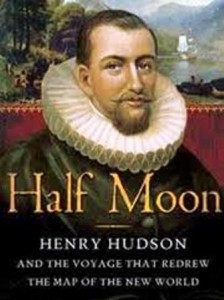 Linda Burton posting from Albany, New York – A lot of good things are discovered while somebody is looking for something else, like a passage to China. The Hudson River Valley is one such example. Now, the river was there eons before Englishman Henry Hudson sailed the Half Moon about as far north as where Albany sits today. That was 1609, when Henry was commissioned by the Dutch East India Company to find a way to get to Asia in a hurry, where they could trade for exotic spices. Henry wasn’t the first European to observe the river; in 1524 Italian explorer Giovanni da Verrazano (sailing for France) sailed all around the Upper Bay; he just didn’t go as far north as Henry did. And before Verrazano came along, the Iroquois, who lived along both banks of the lower portion of the river (now
Linda Burton posting from Albany, New York – A lot of good things are discovered while somebody is looking for something else, like a passage to China. The Hudson River Valley is one such example. Now, the river was there eons before Englishman Henry Hudson sailed the Half Moon about as far north as where Albany sits today. That was 1609, when Henry was commissioned by the Dutch East India Company to find a way to get to Asia in a hurry, where they could trade for exotic spices. Henry wasn’t the first European to observe the river; in 1524 Italian explorer Giovanni da Verrazano (sailing for France) sailed all around the Upper Bay; he just didn’t go as far north as Henry did. And before Verrazano came along, the Iroquois, who lived along both banks of the lower portion of the river (now 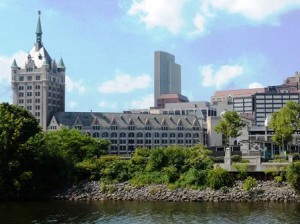 New Jersey and Manhattan) had already named the river “Muhheakantuck” – translate that to “river that flows two ways.” Because the Hudson River is subject to the rise and fall of the tides; as far north as Albany there is a four-foot tide twice a day. The river comes out of Henderson Lake in the Adirondack Mountains and flows 315 miles south before emptying into Upper New York
New Jersey and Manhattan) had already named the river “Muhheakantuck” – translate that to “river that flows two ways.” Because the Hudson River is subject to the rise and fall of the tides; as far north as Albany there is a four-foot tide twice a day. The river comes out of Henderson Lake in the Adirondack Mountains and flows 315 miles south before emptying into Upper New York 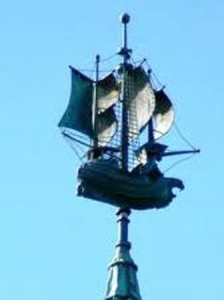 Bay. Its lower half is a tidal estuary; tidal water influences the flow as far north as Troy. I learned that today while sailing on the river myself, on a daily afternoon run of the Dutch Apple Cruises. The cruise started, appropriately enough, with a full-on description of the buildings of Albany alongside the river; with particular attention called to the 800-pound weathervane atop the SUNY headquarters. Hard to make out from a distance, but the narrator assured us it was an exact replica of Henry’s ship, the Half Moon. » read more
Bay. Its lower half is a tidal estuary; tidal water influences the flow as far north as Troy. I learned that today while sailing on the river myself, on a daily afternoon run of the Dutch Apple Cruises. The cruise started, appropriately enough, with a full-on description of the buildings of Albany alongside the river; with particular attention called to the 800-pound weathervane atop the SUNY headquarters. Hard to make out from a distance, but the narrator assured us it was an exact replica of Henry’s ship, the Half Moon. » read more
» posted on Tuesday, August 27th, 2013 by Linda Lou Burton
It’s Really, Really Old
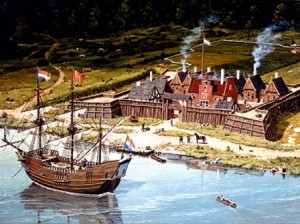 Linda Burton posting from Albany, New York – Age denotes character. Isn’t that what you’ve always heard? If that’s true, then Albany has character aplenty, because Albany is old. Really, really old. It is the longest continuously chartered city in the United States, tracing back to July 22, 1686 when Governor Dongan issued a charter fixing boundaries, setting up a municipal government, naming the first officers, and establishing Albany as the sole market town in the upper Hudson River region. Mayor Pieter Schuyler took the oath of office July 26, 1686, and the rest, as
Linda Burton posting from Albany, New York – Age denotes character. Isn’t that what you’ve always heard? If that’s true, then Albany has character aplenty, because Albany is old. Really, really old. It is the longest continuously chartered city in the United States, tracing back to July 22, 1686 when Governor Dongan issued a charter fixing boundaries, setting up a municipal government, naming the first officers, and establishing Albany as the sole market town in the upper Hudson River region. Mayor Pieter Schuyler took the oath of office July 26, 1686, and the rest, as 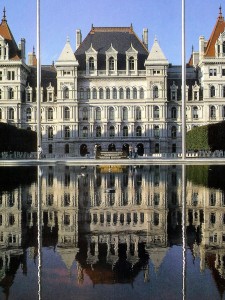 they say, is history. But the European history of the area goes back even further, to 1609, when a fellow by the name of Henry Hudson sailed a ship up the river that now bears his name. This led the Dutch to lay claim to the area; by 1624 the Dutch West India Company had built a trading post on the west bank of the river and named it Fort Orange. There were soldiers for protection, employees to conduct business, and farmers to provide food. By the 1640s a fur trading community had evolved north of the Fort; it took the name Beverwyck. Fast forward; the Fort became less profitable to the Company; there was a devastating Hudson River flood; New Netherland fell to the English. Beverwyck was renamed Albany in
they say, is history. But the European history of the area goes back even further, to 1609, when a fellow by the name of Henry Hudson sailed a ship up the river that now bears his name. This led the Dutch to lay claim to the area; by 1624 the Dutch West India Company had built a trading post on the west bank of the river and named it Fort Orange. There were soldiers for protection, employees to conduct business, and farmers to provide food. By the 1640s a fur trading community had evolved north of the Fort; it took the name Beverwyck. Fast forward; the Fort became less profitable to the Company; there was a devastating Hudson River flood; New Netherland fell to the English. Beverwyck was renamed Albany in 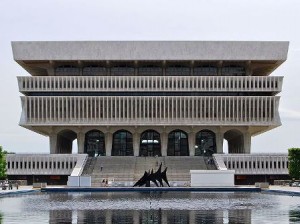 1664, in honor of the Duke of Albany, who later became England’s King James II. The English built a new fort, and that brings us back to the Dongan Charter of 1686. Those are the bones of the Albany story; after a visit to the Empire State Plaza I’ll begin to flesh it out. That’s where the castle-like State Capitol and the sleekly modern Cultural Education Center do a face off, across shimmering pools. » read more
1664, in honor of the Duke of Albany, who later became England’s King James II. The English built a new fort, and that brings us back to the Dongan Charter of 1686. Those are the bones of the Albany story; after a visit to the Empire State Plaza I’ll begin to flesh it out. That’s where the castle-like State Capitol and the sleekly modern Cultural Education Center do a face off, across shimmering pools. » read more
» posted on Sunday, August 25th, 2013 by Linda Lou Burton
A Good Ride
 Linda Burton posting from Albany, New York – Some days are more perfect than others. Today was one of my more perfect days as I drove from Buffalo to Albany. My shoes were still wet from yesterday. But who can complain, when your shoes are soaked by the roaring waters of Niagara Falls. The event is a watery blur in my mind and my pictures don’t help; they mostly show shiny blue ponchos, required clothing on a Maid of the Mist boat ride. I was wearing one myself, but it didn’t prevent the torrent of water that sloshed in over my shoes. Again, and again, and again.
Linda Burton posting from Albany, New York – Some days are more perfect than others. Today was one of my more perfect days as I drove from Buffalo to Albany. My shoes were still wet from yesterday. But who can complain, when your shoes are soaked by the roaring waters of Niagara Falls. The event is a watery blur in my mind and my pictures don’t help; they mostly show shiny blue ponchos, required clothing on a Maid of the Mist boat ride. I was wearing one myself, but it didn’t prevent the torrent of water that sloshed in over my shoes. Again, and again, and again. 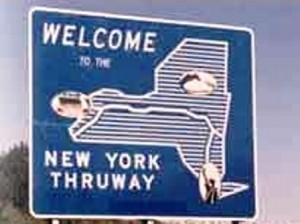 Children shrieked with laughter and mothers gasped as the boat pulled perilously close to American Falls, and then equally close to the Canadian side, and the even bigger Horseshoe Falls. I pulled the front of my poncho down to cover my non-waterproof cameras and blinked the water out of my eyes, unable to hear the narrator, just listening to the roar. And getting wet. Now, that was a good ride; one of those things in life everybody ought to do at least once. I was feeling pretty chipper as I loaded the car this morning in my squishy shoes under blue sky in 70 degree air, perfect. On the outskirts of Buffalo I entered the Toll Plaza
Children shrieked with laughter and mothers gasped as the boat pulled perilously close to American Falls, and then equally close to the Canadian side, and the even bigger Horseshoe Falls. I pulled the front of my poncho down to cover my non-waterproof cameras and blinked the water out of my eyes, unable to hear the narrator, just listening to the roar. And getting wet. Now, that was a good ride; one of those things in life everybody ought to do at least once. I was feeling pretty chipper as I loaded the car this morning in my squishy shoes under blue sky in 70 degree air, perfect. On the outskirts of Buffalo I entered the Toll Plaza 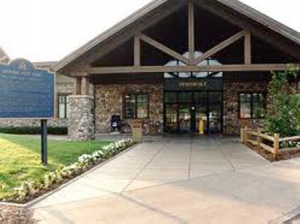 for the I-90 Thruway and got my ticket for another good ride, straight through to Albany. The New York Thruway isn’t fancy and the pavement looks old, but there were no potholes, no construction cones, and few trucks. And best of all, every thirty miles there was a service plaza offering at least three restaurants in a food-court setting, fuel pumps, and information about New York. I stopped at the Pembroke Plaza first, coffee in mind. » read more
for the I-90 Thruway and got my ticket for another good ride, straight through to Albany. The New York Thruway isn’t fancy and the pavement looks old, but there were no potholes, no construction cones, and few trucks. And best of all, every thirty miles there was a service plaza offering at least three restaurants in a food-court setting, fuel pumps, and information about New York. I stopped at the Pembroke Plaza first, coffee in mind. » read more
» posted on Thursday, August 15th, 2013 by Linda Lou Burton
He Never Set Foot
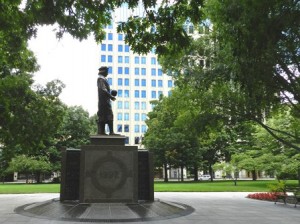 Linda Burton posting from Columbus, Ohio – A statue of Christopher Columbus nestles under the buckeye trees on the southwest corner of the Ohio Statehouse grounds. It isn’t quiet there; the statue faces busy High Street and a main stop for the COTA buses; to his left across State Street the marquee on the Ohio Theater flashes for events; a highrise hotel on the corner welcomes visitors to Columbus. But Chris looks peaceful enough, reflectively studying the globe in his hand. A few blocks away, in Battelle Riverfront Park, the Santa Maria floats gently on the Scioto
Linda Burton posting from Columbus, Ohio – A statue of Christopher Columbus nestles under the buckeye trees on the southwest corner of the Ohio Statehouse grounds. It isn’t quiet there; the statue faces busy High Street and a main stop for the COTA buses; to his left across State Street the marquee on the Ohio Theater flashes for events; a highrise hotel on the corner welcomes visitors to Columbus. But Chris looks peaceful enough, reflectively studying the globe in his hand. A few blocks away, in Battelle Riverfront Park, the Santa Maria floats gently on the Scioto 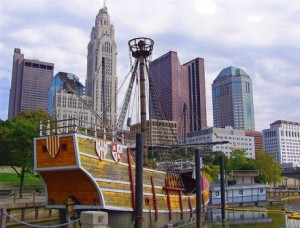 River. It’s a replica of course, open for public tours, and offering educational programs about life, and sailing, in Christopher Columbus times. Chris is a major presence in Columbus, Ohio, even though he never set foot anywhere remotely near. The “explorer’s mystique” surrounds his name; it has been chosen for cities and parks all over the world; his statues are everywhere too. The one on the Ohio Statehouse grounds isn’t a heavy-duty marble; it is crafted of hammered copper plates joined together with rivets and was created in the workshops of W H Mullins Company in Salem, Ohio in
River. It’s a replica of course, open for public tours, and offering educational programs about life, and sailing, in Christopher Columbus times. Chris is a major presence in Columbus, Ohio, even though he never set foot anywhere remotely near. The “explorer’s mystique” surrounds his name; it has been chosen for cities and parks all over the world; his statues are everywhere too. The one on the Ohio Statehouse grounds isn’t a heavy-duty marble; it is crafted of hammered copper plates joined together with rivets and was created in the workshops of W H Mullins Company in Salem, Ohio in 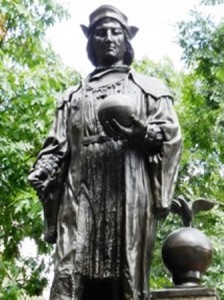 1892, as the 400th anniversary of Columbus’ first voyage approached. Americans looked for ways to recognize what many felt was the beginning of the nation’s history; in Columbus Monsignor Joseph Jessings, founder of Pontifical College Josephenium, commissioned a statue and put it on the grounds of the Seminary. In 1932 the statue was given to the state, and has remained on the Statehouse grounds since. The base was added in 1992, the 500th anniversary of Columbus’ voyage; it was rededicated on Columbus Day; presiding were the Mayors and Governors from Columbus, Ohio and Genoa, Liguria, the Italian city and state thought to be Columbus’ birthplace. » read more
1892, as the 400th anniversary of Columbus’ first voyage approached. Americans looked for ways to recognize what many felt was the beginning of the nation’s history; in Columbus Monsignor Joseph Jessings, founder of Pontifical College Josephenium, commissioned a statue and put it on the grounds of the Seminary. In 1932 the statue was given to the state, and has remained on the Statehouse grounds since. The base was added in 1992, the 500th anniversary of Columbus’ voyage; it was rededicated on Columbus Day; presiding were the Mayors and Governors from Columbus, Ohio and Genoa, Liguria, the Italian city and state thought to be Columbus’ birthplace. » read more
» posted on Tuesday, August 13th, 2013 by Linda Lou Burton
Make A Plan
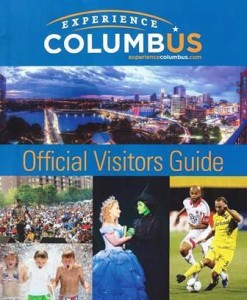 Linda Burton posting from Columbus, Ohio – “Plan Your Visit” is a category unto itself when you travel. It’s also wise advice for living on this earth. “If you don’t know where you’re going, you might end up somewhere else,” is a sage bit of advice I’ve passed along to my grandkids over the years. That doesn’t mean you don’t adapt, and change plans as necessary (or desirable); it just means you have a plan. Like a Journey to 50 capital cities! Today I’m ready to make a plan for my visit in Columbus, my 39th capital city. I always seek advice from the locals – residents, and those whose task it is to promote the city, such as the visitor’s bureau; here in Columbus they go by the moniker “Experience Columbus,” which, to me, is good advice for residents as well as visitors. I have in hand the Official Visitors Guide, complete with maps,
Linda Burton posting from Columbus, Ohio – “Plan Your Visit” is a category unto itself when you travel. It’s also wise advice for living on this earth. “If you don’t know where you’re going, you might end up somewhere else,” is a sage bit of advice I’ve passed along to my grandkids over the years. That doesn’t mean you don’t adapt, and change plans as necessary (or desirable); it just means you have a plan. Like a Journey to 50 capital cities! Today I’m ready to make a plan for my visit in Columbus, my 39th capital city. I always seek advice from the locals – residents, and those whose task it is to promote the city, such as the visitor’s bureau; here in Columbus they go by the moniker “Experience Columbus,” which, to me, is good advice for residents as well as visitors. I have in hand the Official Visitors Guide, complete with maps, 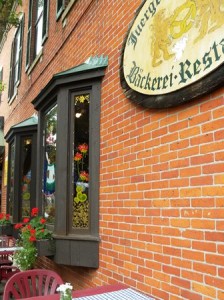 and Columbus City Guide (from Columbus Monthly), so I’m going to read all about it, and make my plan. Neighborhoods and tours, historical sites and adventuring, eating and events – those are the basics. I see there are some interesting neighborhoods, such as Short North (so named because it is north of downtown, but short of the OSU campus); the Arena District (sports, natch);
and Columbus City Guide (from Columbus Monthly), so I’m going to read all about it, and make my plan. Neighborhoods and tours, historical sites and adventuring, eating and events – those are the basics. I see there are some interesting neighborhoods, such as Short North (so named because it is north of downtown, but short of the OSU campus); the Arena District (sports, natch);  German Village (historic, south of downtown); Victorian Village/Italian Village (historic, north of downtown); Olde Towne (vintage Columbus); and of course, Downtown, home of the Statehouse, the Museum of Art, and COSI (Center of Science and Industry), a 320,000-square-foot facility that recently was named America’s #1 science center. America’s #1 science center and America’s #1 zoo in one town? I settled in to read more. Jack Hanna is Director Emeritus of the Columbus Zoo, I read. Well then, no wonder it is great! » read more
German Village (historic, south of downtown); Victorian Village/Italian Village (historic, north of downtown); Olde Towne (vintage Columbus); and of course, Downtown, home of the Statehouse, the Museum of Art, and COSI (Center of Science and Industry), a 320,000-square-foot facility that recently was named America’s #1 science center. America’s #1 science center and America’s #1 zoo in one town? I settled in to read more. Jack Hanna is Director Emeritus of the Columbus Zoo, I read. Well then, no wonder it is great! » read more
» posted on Monday, August 12th, 2013 by Linda Lou Burton
Right Here In Ohio
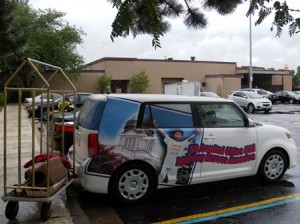 Linda Burton posting from Columbus, Ohio – The minute I crossed the state line into Ohio, two things happened. The road improved, and the rain stopped. I had loaded the car in a sprinkle; there was just enough rain to trickle down my neck. The deluge waited until I-96 towards Detroit; from there the wiper was set on triple speed and even that wasn’t enough. The trip from Lansing to Columbus was just 267 miles, but after two hours in the driving rain I stopped at an Arby’s to give my knuckles a break from their painful grip on the steering wheel. “I hear it’s supposed to
Linda Burton posting from Columbus, Ohio – The minute I crossed the state line into Ohio, two things happened. The road improved, and the rain stopped. I had loaded the car in a sprinkle; there was just enough rain to trickle down my neck. The deluge waited until I-96 towards Detroit; from there the wiper was set on triple speed and even that wasn’t enough. The trip from Lansing to Columbus was just 267 miles, but after two hours in the driving rain I stopped at an Arby’s to give my knuckles a break from their painful grip on the steering wheel. “I hear it’s supposed to 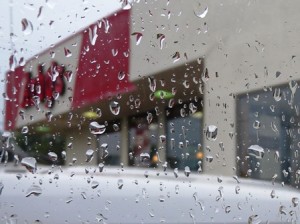 rain all day,” said the young woman who handed me my Jr Ham and Swiss. “And the real storm is coming through this afternoon.” Rats! I missed something in the weather forecast; I remembered seeing round balls of yellow on the screen as I packed last night; how did I miss a predicted front, wildly coming at us from the west? “You just have to deal with it,” I told myself. “Drive on.” The GPS directed me onto US23 south towards Ann Arbor and Ypsilanti; I crossed a few rivers flowing towards Lake Erie, just to the east. The landscape was heavily treed,
rain all day,” said the young woman who handed me my Jr Ham and Swiss. “And the real storm is coming through this afternoon.” Rats! I missed something in the weather forecast; I remembered seeing round balls of yellow on the screen as I packed last night; how did I miss a predicted front, wildly coming at us from the west? “You just have to deal with it,” I told myself. “Drive on.” The GPS directed me onto US23 south towards Ann Arbor and Ypsilanti; I crossed a few rivers flowing towards Lake Erie, just to the east. The landscape was heavily treed, 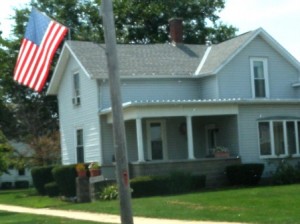 though I spotted a few patches of corn here and there. And then, I was in Ohio, and the sky was blue. US23 became I-475, and then, I-75. I spotted signs for BGSU (Bowling Green State University); at Findlay a sign proclaimed Flag City USA. Then Exit 156. Suddenly I was on a two-lane road surrounded by farms, and silos, and sun-drenched fields. I passed through Arlington, and Williamstown, small towns where every corner had an American flag and every house had a front porch. At Dunkirk I stopped for gas. » read more
though I spotted a few patches of corn here and there. And then, I was in Ohio, and the sky was blue. US23 became I-475, and then, I-75. I spotted signs for BGSU (Bowling Green State University); at Findlay a sign proclaimed Flag City USA. Then Exit 156. Suddenly I was on a two-lane road surrounded by farms, and silos, and sun-drenched fields. I passed through Arlington, and Williamstown, small towns where every corner had an American flag and every house had a front porch. At Dunkirk I stopped for gas. » read more
» posted on Friday, August 9th, 2013 by Linda Lou Burton
What’s In A Name
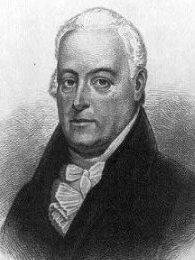 Linda Burton posting from Lansing, Michigan – History has a way of surprising you. That is, the pursuit of getting to the bottom of things, like, for instance, how Lansing, Michigan got its name. This tale is full of twists and turns, beginning with a man named John Ten Eyck Lansing Jr (1754-1829), who lived in New York. He was a distinguished fellow; in his lifetime he was Mayor of Albany, New York; Chief Justice of the New York Supreme Court, a member of the New York State Assembly, and in 1785, the US Confederation Congress. During the Revolutionary War he was military secretary to General Philip Schuyler, which brings us to the Central New York Military Tract. In September of 1776 the Continental Congress required states to raise regiments for the Revolutionary War, so the New York legislature authorized a military tract as part of law, to raise its quota of regiments. Nearly two million acres of bounty land were set aside to compensate New York’s soldiers; each soldier was guaranteed 600 acres for their service. The land was surveyed and divided into
Linda Burton posting from Lansing, Michigan – History has a way of surprising you. That is, the pursuit of getting to the bottom of things, like, for instance, how Lansing, Michigan got its name. This tale is full of twists and turns, beginning with a man named John Ten Eyck Lansing Jr (1754-1829), who lived in New York. He was a distinguished fellow; in his lifetime he was Mayor of Albany, New York; Chief Justice of the New York Supreme Court, a member of the New York State Assembly, and in 1785, the US Confederation Congress. During the Revolutionary War he was military secretary to General Philip Schuyler, which brings us to the Central New York Military Tract. In September of 1776 the Continental Congress required states to raise regiments for the Revolutionary War, so the New York legislature authorized a military tract as part of law, to raise its quota of regiments. Nearly two million acres of bounty land were set aside to compensate New York’s soldiers; each soldier was guaranteed 600 acres for their service. The land was surveyed and divided into  28 townships; the townships were given classical Greek and Roman names, and a few honoring English authors, one of which was Milton, near Cayuga Lake. The township of Milton was split over time; the part in Cayuga County was named Genoa. In 1817 when Tompkins County was created out of Cayuga County, the town of Lansing, New York was established; history tells us it was named for the well-known John Ten Eyck Lansing Jr. So what does any of this have to do with Lansing, Michigan? Think of dense forests, flowing rivers, and land. That’s what Michigan Territory offered; and land attracted land speculators, like brothers Jerry and William Ford, who came to Michigan in 1835. » read more
28 townships; the townships were given classical Greek and Roman names, and a few honoring English authors, one of which was Milton, near Cayuga Lake. The township of Milton was split over time; the part in Cayuga County was named Genoa. In 1817 when Tompkins County was created out of Cayuga County, the town of Lansing, New York was established; history tells us it was named for the well-known John Ten Eyck Lansing Jr. So what does any of this have to do with Lansing, Michigan? Think of dense forests, flowing rivers, and land. That’s what Michigan Territory offered; and land attracted land speculators, like brothers Jerry and William Ford, who came to Michigan in 1835. » read more
» posted on Wednesday, August 7th, 2013 by Linda Lou Burton
Reach For The Stars
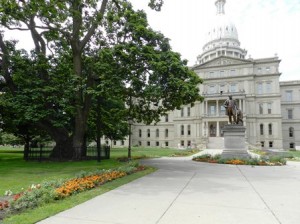 Linda Burton posting from Lansing, Michigan – The catalpa tree was already there when architect Elijah Meyers came to build a capitol. “We figure it’s more than 140 years old,” the groundskeepers told me. Construction on the third Michigan state capitol began in the summer of 1872; the catalpa would have grown as the capitol grew. From the day of the capitol’s dedication on January 1, 1879 until today, when I came for a visit, the catalpa has stood just to the left of the front sidewalk, watching over everything. It is well over a hundred feet tall and 85 feet across
Linda Burton posting from Lansing, Michigan – The catalpa tree was already there when architect Elijah Meyers came to build a capitol. “We figure it’s more than 140 years old,” the groundskeepers told me. Construction on the third Michigan state capitol began in the summer of 1872; the catalpa would have grown as the capitol grew. From the day of the capitol’s dedication on January 1, 1879 until today, when I came for a visit, the catalpa has stood just to the left of the front sidewalk, watching over everything. It is well over a hundred feet tall and 85 feet across 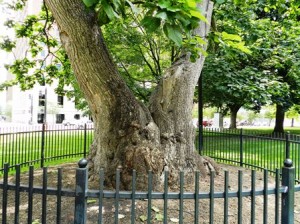 its crown, one of the biggest of its kind in the country. It is fenced for its protection, and steel posts now support two of its extensive limbs; its 20-foot trunk is split, from earliest days, it appears. But it is wearing its age well and each year produces a hearty crop of long thin seed-filled pods, which the groundskeepers collect and give to the Michigan State University arborists for “starting.” Plantings are shared with the community; you might find this catalpa’s babies all over Lansing. “All trees that grow from this tree’s seed split too,” I was
its crown, one of the biggest of its kind in the country. It is fenced for its protection, and steel posts now support two of its extensive limbs; its 20-foot trunk is split, from earliest days, it appears. But it is wearing its age well and each year produces a hearty crop of long thin seed-filled pods, which the groundskeepers collect and give to the Michigan State University arborists for “starting.” Plantings are shared with the community; you might find this catalpa’s babies all over Lansing. “All trees that grow from this tree’s seed split too,” I was  told, as I was handed a seed pod to keep for my own treasure. I tucked it into my backpack and headed on towards the capitol entrance. No steps and no mystery; a clearly marked ground-floor entrance led me directly to the Visitor Information desk, where Matt VanAcker welcomed me and gave me information about the capitol. “A few days ago, there were no desks or chairs in the chambers,” he said. “We are just getting back in order after some major renovation.” I headed for the first floor rotunda, where the tour was already underway, booklet of facts in hand. » read more
told, as I was handed a seed pod to keep for my own treasure. I tucked it into my backpack and headed on towards the capitol entrance. No steps and no mystery; a clearly marked ground-floor entrance led me directly to the Visitor Information desk, where Matt VanAcker welcomed me and gave me information about the capitol. “A few days ago, there were no desks or chairs in the chambers,” he said. “We are just getting back in order after some major renovation.” I headed for the first floor rotunda, where the tour was already underway, booklet of facts in hand. » read more
» posted on Sunday, August 4th, 2013 by Linda Lou Burton
Turn The Radio On
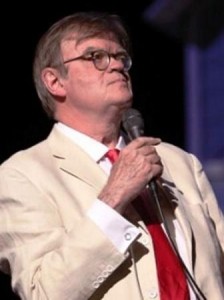 Linda Burton posting from Lansing, Michigan – First he had us stand and sing the Star Spangled Banner. There was no fanfare, no “Here’s…….Johnny!” introduction, no curtain raised. Garrison Keillor simply walked out on the stage and asked us to stand and sing. At the end of two hours, he asked us to stand and sing again; this time it was Amazing Grace; and we did it, respectfully and, I’d say, rather enthusiastically. “What is such a tactic supposed to do for the show?” I was thinking, as I stood between two guys whose baritone voices completely drowned me out. I guess it served two purposes; a method of getting audience involvement so we’d stop chatting with each other and pay attention to the show in the beginning; a seventh-inning stretch after we’d sat so long. Or maybe he’s just patriotic. He is that; patriotic, I mean; and irreverent too. Somehow he picks out exactly how
Linda Burton posting from Lansing, Michigan – First he had us stand and sing the Star Spangled Banner. There was no fanfare, no “Here’s…….Johnny!” introduction, no curtain raised. Garrison Keillor simply walked out on the stage and asked us to stand and sing. At the end of two hours, he asked us to stand and sing again; this time it was Amazing Grace; and we did it, respectfully and, I’d say, rather enthusiastically. “What is such a tactic supposed to do for the show?” I was thinking, as I stood between two guys whose baritone voices completely drowned me out. I guess it served two purposes; a method of getting audience involvement so we’d stop chatting with each other and pay attention to the show in the beginning; a seventh-inning stretch after we’d sat so long. Or maybe he’s just patriotic. He is that; patriotic, I mean; and irreverent too. Somehow he picks out exactly how 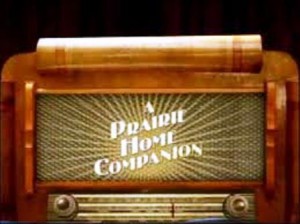 we feel about something even when we think we have gracefully covered it up. And he tells on us. Faithful listeners of A Prairie Home Companion know just what I mean. Pastor Liz. The Lutherans. Those folks who endure a Minnesota winter. Garrison Keillor knows about contentment, and he knows about longing; he gives the two a humorous twist; that’s the way to survive. He ended the show with a singy-song burst of advice for happy living – “If you want something to get done…do it…if you don’t want to do it, don’t worry a-bout it…tell
we feel about something even when we think we have gracefully covered it up. And he tells on us. Faithful listeners of A Prairie Home Companion know just what I mean. Pastor Liz. The Lutherans. Those folks who endure a Minnesota winter. Garrison Keillor knows about contentment, and he knows about longing; he gives the two a humorous twist; that’s the way to survive. He ended the show with a singy-song burst of advice for happy living – “If you want something to get done…do it…if you don’t want to do it, don’t worry a-bout it…tell  your kids not to wear their baseball cap back-wards and not to use four-letter words on their res-u-me….” If you haven’t figured it out, I was in the audience for Garrison Keillor’s Radio Romance Summer Tour. I was front row balcony in Lansing’s Wharton Center, and I was loving it. » read more
your kids not to wear their baseball cap back-wards and not to use four-letter words on their res-u-me….” If you haven’t figured it out, I was in the audience for Garrison Keillor’s Radio Romance Summer Tour. I was front row balcony in Lansing’s Wharton Center, and I was loving it. » read more
» posted on Saturday, August 3rd, 2013 by Linda Lou Burton
If You Only Have Time
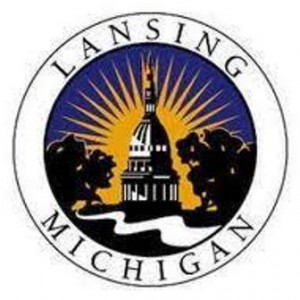 Linda Burton posting from Lansing, Michigan – “If you only have time for one thing,” begins the “Stellar Tip” from Christine Bennett in the Greater Lansing 2013 Visitor Guide, “make sure to visit the State Capitol.” Now, there’s a Visitor Guide after my own heart, as I’ve been digging deep into capitols for 38 states to this point; I love it when they are recognized as a Top Attraction in their own city. “Step back to the Victorian era,” are the tantalizing words they offer, followed by; “award-winning Capitol Building;” and “nine acres of hand-painted surfaces.” An image is forming in my mind and I’m eager to go; I see that tours are available every half hour on Mondays through Fridays from 9
Linda Burton posting from Lansing, Michigan – “If you only have time for one thing,” begins the “Stellar Tip” from Christine Bennett in the Greater Lansing 2013 Visitor Guide, “make sure to visit the State Capitol.” Now, there’s a Visitor Guide after my own heart, as I’ve been digging deep into capitols for 38 states to this point; I love it when they are recognized as a Top Attraction in their own city. “Step back to the Victorian era,” are the tantalizing words they offer, followed by; “award-winning Capitol Building;” and “nine acres of hand-painted surfaces.” An image is forming in my mind and I’m eager to go; I see that tours are available every half hour on Mondays through Fridays from 9 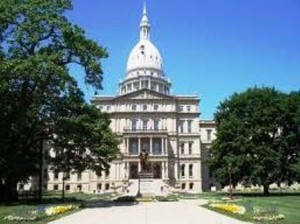 to 4. Oops, no weekends? Hmmm, weekends are important times to draw visitors. What else do people do on the weekends in Greater Lansing? For Historic Sites I note some memorials and markers that may be visited at any time: the Remembrance Memorial honoring those who died on 9/11; the Michigan Vietnam Veterans Memorial, honoring the 2,651 Michigan casualties of that war; the Malcolm X Homesite Marker, a registered historical landmark where he once lived. The Michigan Walk of Fame invites a leisure stroll
to 4. Oops, no weekends? Hmmm, weekends are important times to draw visitors. What else do people do on the weekends in Greater Lansing? For Historic Sites I note some memorials and markers that may be visited at any time: the Remembrance Memorial honoring those who died on 9/11; the Michigan Vietnam Veterans Memorial, honoring the 2,651 Michigan casualties of that war; the Malcolm X Homesite Marker, a registered historical landmark where he once lived. The Michigan Walk of Fame invites a leisure stroll  any day of the week; it is downtown on the sidewalks of Washington Square and honors the “ingenuity and resourcefulness of Michigan residents” – that would give a lot of insight into what Lansing, and Michigan, are all about. The Potter Park Zoo is open daily, as is the Michigan Historical Museum. The Impression 5 Science Center is open Tuesdays through Sundays, as is the R E Olds Transportation Museum; okay, it’s going to take grid paper for a chart. Fit “time” into what promises to be an interesting city – now there’s the challenge! » read more
any day of the week; it is downtown on the sidewalks of Washington Square and honors the “ingenuity and resourcefulness of Michigan residents” – that would give a lot of insight into what Lansing, and Michigan, are all about. The Potter Park Zoo is open daily, as is the Michigan Historical Museum. The Impression 5 Science Center is open Tuesdays through Sundays, as is the R E Olds Transportation Museum; okay, it’s going to take grid paper for a chart. Fit “time” into what promises to be an interesting city – now there’s the challenge! » read more
